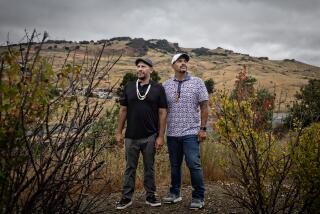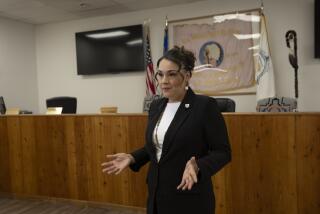Marines Honor Navajo Code Talkers Who Kept Japanese Guessing in War
- Share via
N ihima, ch’ah ligia, ch’al.
It means nothing to most. But to American Marines during World War II, such words were used to code secret combat messages and transmit classified documents in a way that baffled the enemy.
More than 400 Marines, recruited from Navajo tribes in Arizona, New Mexico, Colorado and Utah, served as code talkers during the war by sending messages in the Navajo language.
Four code talkers were honored Friday at the San Diego Marine Corps Recruit Depot during graduation ceremonies for the 270 men in Company M. The code talkers are in town for the San Diego Museum of Man Indian Fair, being held today and Sunday.
“They didn’t tell us we’d be coding when they recruited us,” said Thomas Begay, a code talker who now lives on a Navajo reservation in Gallup, N.M. Begay, recruited in 1943 at age 16, said Marine recruiters looked for men on Navajo reservations fluent in English and Navajo. The Navajos thought they would be regular soldiers, he said.
The unwritten Navajo language, difficult to master because of its complex syntax and intricate tonal qualities, was adopted by the Marine Corps during the war as a voice code because Japanese intelligence experts had broken every other code the United States devised. Some estimated that no more than 28 persons outside the Navajo tribe understood the language at the time.
The code talkers would take the letters of each word of the message in English, and devise a code in which they would pick an English word that began with each letter, but translate the word into Navajo. The system required a Navajo at each end, one to transmit, the other to translate the Navajo words back into English and use the initial letters to spell out the message.
“It could not be deciphered by the enemy, which were the Japanese at that time. We developed our own terminology for names of units, boats, planes, everything,” said Keith Little, a code talker from an Indian reservation in Crystal, N.M.
Among the code words they devised were nihima, ch’ah ligia, ch’al-- which translate to our mother, white hats and frog . In the code, they would mean America, sailors and amphibious. Japanese cryptographers were never able to break the Navajo-based code.
“The code talkers’ greatest claim to fame was that they used their Indian heritage to help the war effort. They saved thousands of lives,” Lt. Tony Wells, spokesman at MCRD, said.
Begay and Little were joined by code talkers Wilson H. Price of Costa Mesa and Carl Gorman of Window Rock, Ariz., the capital of the Navajo Nation. For the day’s events, all four men donned their code talkers uniforms, maize-colored shirts, red caps and Navajo-made conch belts of silver and turquoise--a tribute to both military dress and Indian heritage.
While in the service, Begay and Price landed with troops at Iwo Jima on Feb. 19, 1945, and were present when the famous battle photograph was taken during the second flag raising on that island.
“I was quite young when I landed on Iwo Jima. I was right there when they raised that flag,” Begay said.
The confusing chatter of code talkers like Begay and Price on Iwo Jima was so effective that Maj. Howard Conner, signal officer of the 5th Marine Division at Iwo Jima, has been quoted as saying, “Were it not for the Navajos, the Marines would never have taken Iwo Jima.” Begay and Price served under Conner.
Although the Marines initially had 30 Navajo recruits, that number later soared to 420. All went through boot camp at MCRD and were trained in coding at the Marine communications school at Camp Pendleton, where they were required to memorize codes as well as learn to set up and maintain radio equipment.
Code talkers also fought in combat.
“There was always somebody guarding us because we were classified as top secret. We couldn’t talk about it,” Price said. His wife, Rose Price, said she was not even aware that he had been a code talker until after his retirement in 1972, after 30 years of service in the Marines.
Although the military can now scramble messages electronically, Navajo code talkers were a fast, efficient way to scramble messages during World War II. In fact, Begay and Price were part of a team of four code talkers who beat four other Marines, who used conventional coding procedures, in speed and accuracy of message transmissions.
“We would take those messages from our officers and code them in Navajo. We had to do it fast, in a split second,” Begay said.
More to Read
Sign up for Essential California
The most important California stories and recommendations in your inbox every morning.
You may occasionally receive promotional content from the Los Angeles Times.










